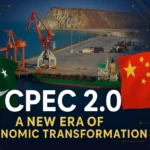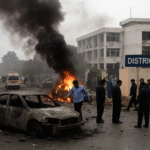A decade after the launch of the China Pakistan Economic Corridor CPEC the relationship between Islamabad and Beijing is evolving from construction to creation from building infrastructure to building industries.
With CPEC Phase II now officially launched Pakistan and China have entered what officials call the Era of Economic Transformation. The focus has shifted toward industrialisation technology transfer renewable energy and human development the key pillars that could determine Pakistan’s long-term economic survival and its place in the global order.
Background: From Highways to High-Tech Horizons
CPEC began in 2015 as the flagship project of China’s Belt and Road Initiative BRI a 62 billion dollar plan to link western China’s Xinjiang region to Pakistan’s Arabian Sea port at Gwadar.
In its first decade CPEC built highways power plants and ports that physically connected the two nations. Today it stands at a crossroads. Phase II is no longer about roads and electricity alone it is about industrial growth export-driven production and human capital development.
During the 14th Joint Cooperation Committee JCC meeting in Beijing both governments signed a new Long-Term Plan 2025–2029. The updated framework defines five major development corridors Growth Innovation Green Development Livelihood and Regional Connectivity signalling a shift toward sustainability and inclusivity.
The New Face of CPEC Phase II
1. Industrialisation and Technology
CPEC Phase II places heavy emphasis on industrial parks technology zones and digital infrastructure. Pakistan aims to attract investment in electronics EV manufacturing and robotics while benefiting from Chinese technology transfer and skill development programs.
The Special Investment Facilitation Council SIFC has been tasked to ensure transparency faster approvals and protection of foreign investors marking a major policy shift from the bureaucratic delays of the past.
2. Green and Sustainable Development
In contrast to the energy-heavy projects of Phase I the new phase promotes renewable energy eco-friendly transportation and sustainable industry. Solar wind and hydro projects are expected to replace older carbon-intensive models making green growth a central pillar of Pakistan’s future.
3. Inclusive Regional Development
For the first time the corridor’s benefits are being expanded beyond Punjab and Sindh. Provinces like Balochistan and Khyber Pakhtunkhwa will host new Special Economic Zones SEZs while major upgradation of the Karakoram Highway promises better regional trade routes linking Pakistan China and Central Asia.
4. Human Capital and Governance Reform
Phase II focuses strongly on education vocational training and women’s participation in economic activities. Pakistan has declared 2026 the Year of Reform and Modernisation aiming to simplify regulations curb corruption and encourage youth-driven innovation.
5. Security and Investor Confidence
Recognising the challenges of past attacks on CPEC workers Pakistan has strengthened its CPEC Security Division and improved intelligence coordination to safeguard Chinese nationals and investments a critical factor for long-term stability.
Economic Implications for Pakistan
-
A Shift from Consumption to Production
CPEC 2.0 aims to convert Pakistan from a consumer market into a production and export-driven economy reducing reliance on imports and external aid. -
Job Creation and Skills Development
The industrial parks and technology corridors are expected to create tens of thousands of jobs especially for skilled youth and engineers. -
Boost to Regional Connectivity
Gwadar’s upgraded port and new road networks will link Pakistan with Iran Afghanistan and Central Asia positioning it as a regional trade hub. -
Foreign Direct Investment FDI
With China’s renewed commitment Pakistan could witness a surge in FDI in manufacturing mining agriculture and information technology crucial for economic revival. -
Stronger Pakistan China Strategic Bond
Beyond economics CPEC Phase II reinforces Pakistan’s strategic partnership with Beijing ensuring long-term cooperation in defense energy and technology sectors.
Challenges on the Horizon
Despite its promise CPEC Phase II faces serious hurdles.
• Debt Pressure Pakistan must balance foreign borrowing with economic sovereignty.
• Governance Issues Corruption bureaucratic red tape and inter-provincial disputes remain persistent threats.
• Security Risks Militancy in Balochistan and KP continues to challenge investor confidence.
• Industrial Competition Without strong policy safeguards domestic industries could be overshadowed by Chinese firms.
• Global Geopolitics Aligning closely with China might complicate Pakistan’s relations with the United States and Gulf allies.
Strategic Outlook: What Lies Ahead
CPEC Phase II will test Pakistan’s economic discipline political unity and governance capacity. Its success depends on how quickly Pakistan operationalises Special Economic Zones SEZs how well provinces share the benefits of new projects and how effectively Islamabad protects foreign investors and local communities alike.
If these conditions are met CPEC Phase II could transform Pakistan from a logistical corridor into a center of industrial growth and regional connectivity.
Conclusion
CPEC Phase II is more than an economic project it is a test of national will and vision. It offers Pakistan the chance to escape its cycle of dependency embrace technology and strengthen its role as China’s most vital partner in the region.
But opportunity alone is not enough. Without good governance security and local participation even the most ambitious blueprint can fail. The success of CPEC 2.0 will depend on how Pakistan reforms itself not just how much China invests.
If done right this could become the turning point in Pakistan’s modern history where economic sovereignty replaces aid dependency and where Gwadar becomes not just a port but a symbol of national resurgence.










